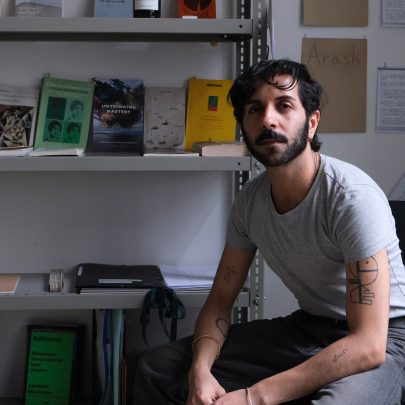Dec 11, 2014 Art
A personal response to Simon Denny’s Walters Prize entry.
Simon Denny: The Art of Success. Henry Oliver profile’s New Zealand’s most successful contemporary artist.
The first thing I wondered was, what’s it doing in an art gallery? Not because it doesn’t look like art — what does art look like? — but because it would work so much better in the middle of Aotea Square or on the platforms at Britomart.
Maybe that’s true for most art. Maybe we have galleries because we can’t always have art in railway stations. No, what? Why can’t we always have art in railway stations?
That’s Simon Denny for you. Gives you a room full of stuff and immediately you’re off, asking, wondering, chasing ideas down rabbit holes. Big tick for any artwork that can pull that off, I reckon, especially when it’s work like this, because you definitely don’t go to a Denny show for the aesthetics. It looks like crap. You’re not stirred by beauty or anything visually subversive or sublime. It’s not that kind of art.
All You Need Is Data, on show recently at the Auckland Art Gallery as a Walters Prize finalist, is set out like a zigzag queue — the kind of thing they set up in airports and at the multiplex. That’s another reason it feels like it belongs out in public.
The lanes are divided by galvanised tube railings, though, not spooled-out fabric belts, and attached to them are dozens of placards. The backdrop on most of these is a photo of a rustically got-up room: bare boards for walls and floor, animal trophies. It looks like a studio set-up of some cabin in the woods. On each placard, there’s a main photo of a person and various smaller photos, and all of these have been crudely taped or pinned to the photo of the room. And there are quotes, typed across the placards:
Data is the oil of the 21st century.
The age when people can make what they want to have is coming.
University, surprisingly, is the least innovative of all structures in society.
The show is a visual record of a digital technology conference that took place in a hunting lodge, where a whole bunch of entrepreneurs, artists, academics, business people, musicians, writers and techno-wizards all tried — or so it seems — to outdo each other with definitively catchy statements about how technology is defining our future:
There is no such thing as information overload. There is only filter failure.
Imagination is the ultimate renewable resource.
The statements are both profound and banal, which is also true for what Denny has done.
His banality is deliberate. Well, of course it is: he’s a contemporary artist, everything is deliberate. Those torn strips of tape, the amateurish angled snapshots — they all serve to undercut the high-minded intentions of the speakers. It’s low-tech: the entire thing is constructed as if no one had invented the personal computer.
Why’s he done it like this? “What’s great about art is that it can have ambiguity in it,” Denny says, and that ambiguity seems the essential purpose here. Is he saying ideas are only ideas? Nothing should be sacred?
Or is it that ideas — the process of thinking, filling ourselves with reason and empathy — is humanity at its best, so it should be sacred, but in the digital era ideas have been deconsecrated?
Or is it that ideas are still sacred, but mostly they are rendered in banal ways — slogans, pop songs, placards — and yet even when that happens, they do not lose their power? Ideas survive, regardless of how they are debased?
So is this a bunch of geekie Hallmark cards for people standing in a queue? Banal, and yet somehow still a conduit to valued feelings. “Tomorrow is the first day of the rest of your life” is a cliché, but it’s also, in a deep sense no less than a trivial one, true.
Jeff Koons is in similar territory when he puts a giant shiny balloon puppy on display, isn’t he? Art as an exercise in mass democratisation.
Also, art as commodity production: you can buy a section of Denny’s railings with a few placards on it. That makes it art as the negation of itself: giving the work commercial value by chopping it into bits reinforces its status (and therefore the artist’s) even as it diminishes its power and purpose, because the whole is far more than the sum of its parts.
And it’s art doing what it has always done: begging for analysis and yet ultimately defying explanation. Art as the condition of our lives. I spent a good hour in that room and didn’t want to leave. I’m serious about Aotea Square and Britomart, by the way. Queens Wharf would be good too.





